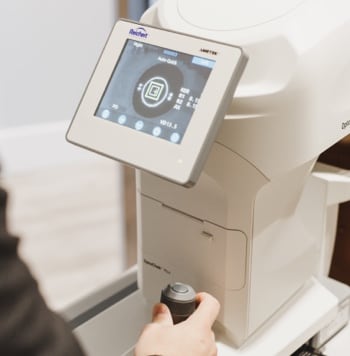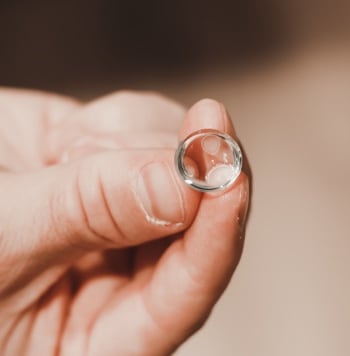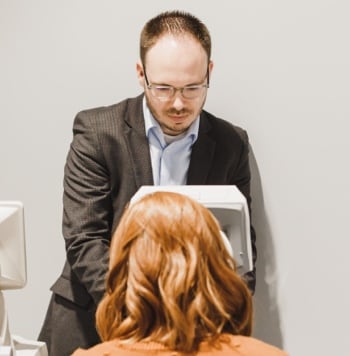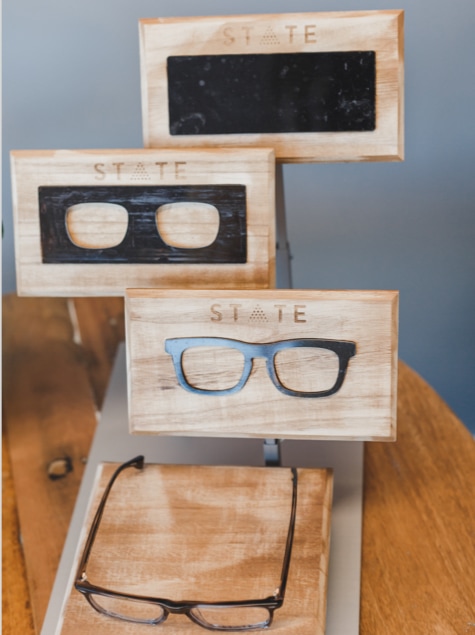Specialty Contact Lenses
For those with corneal irregularities, such as astigmatism or keratoconus, typical styles of contact lenses may be uncomfortable. At Copper View Eye Care, we can fit you with specialty contact lenses that suit atypical eyes.
Scleral Lenses
Scleral lenses are larger than standard lenses and are generally made of a rigid plastic material that allows oxygen to reach the eye. The lenses rest on the sclera, or whites of the eyes, and vault over the cornea, creating a smooth surface for light to pass through and correcting distorted vision caused by a corneal irregularity.

Orthokeratology
Orthokeratology, or ortho-k lenses, are specially-designed rigid gas permeable contacts that temporarily reshape the cornea. They are typically worn at night to flatten the cornea and are removed during the day. They need to be worn consistently for long-lasting vision correction, as your cornea will return to normal if you stop wearing them.
Ortho-k is one of the first myopia vision correction options that has also been recognized to provide a myopia control effect, with current research indicating that ortho-k offers around a 50% myopia control effect. This means that ortho-k slows myopia progression by around a half compared to vision correction with standard single vision glasses or contact lenses.
Eye Disease Diagnosis & Management
Glaucoma
Glaucoma is a progressive group of eye conditions related to optic nerve damage. Glaucoma is most often caused by a buildup of fluid inside the eye, causing intraocular pressure to rise and create stress on the optic nerve.
There are 2 primary types of glaucoma:
- Primary open-angle glaucoma
- Angle-closure glaucoma
Age-Related Macular Degeneration
Age-related macular degeneration is an age-related eye condition that affects your central vision. Typically caused by damage to the central most part of the retina, called the macula, AMD can cause permanent and severe vision loss if not treated early.
There are 2 types of AMD:
- Dry AMD
- Wet AMD
Cataracts
Cataracts occur when the clear lens in the eye becomes cloudy over time, creating what can appear to be a “veil” over your vision. Research has shown that a good diet, exercise, and proper eye protection can prevent them from developing.
Refractive Surgery Co-Management
Refractive surgery can be an excellent option for individuals who need vision correction but no longer want to wear eyeglasses or contact lenses. At Copper View Eye Care, we want to ensure you feel knowledgeable and comfortable about refractive surgery before, during, and after your procedure.
LASIK
Laser in-situ keratomileusis, or LASIK, is one of the most common refractive surgical procedures.
LASIK uses a highly precise laser to create a flap in the cornea’s outer layer, called the epithelium. The flap is pushed back to reveal the corneal tissue underneath, and a laser is used to reshape the cornea. The flap is then replaced to act as a natural bandage.
Other common types of refractive surgery include:
PRK
PRK is a type of refractive surgery that is essentially laser eye surgery like LASIK but without a corneal flap. During photorefractive keratectomy (PRK), an excimer laser is used to reshape your cornea. And like LASIK surgery, you will enjoy phenomenal visual results, giving you freedom from contact lenses and glasses. The only trade-off with LASIK is the visual recovery of PRK surgery is slightly longer.
ICL
ICL means Implantable Collamer Lens and is a state-of-the-art vision correction procedure. The EVO ICL lens (previous iteration known as Visian ICL) is placed inside the eye behind the iris (the colored part of the eye) and helps correct nearsightedness and astigmatism. The EVO ICL lenses are safe, effective, UV protective, and give a phenomenal visual result. You have many vision correction options, and ICLs can give you better vision than LASIK in certain cases. In fact, if you are very nearsighted, this may be the best option for vision correction.
State-of-the-Art Technology
Corneal Topography
Corneal topography is a specialized imaging technique used to measure the eye’s surface in a similar way to how a mountain is shown on a map. The process is non-invasive and generally painless and is used to detect and diagnose irregularities in the cornea, such as astigmatism.
Slit Lamp Photography & Video
A slit lamp is a tool used in most comprehensive eye exams to take a closer look at your eye’s interior and external surface. Your optometrist uses it to shine a bright light into your eye and capture high-quality photos and videos of your eye. This tool is useful for monitoring your ocular health and screening for any changes.
Tonometry
Tonometry is a diagnostic tool used to detect high intraocular pressure, a common symptom of glaucoma. At Copper View Eye Care, we use the ICare tonometer, which is non-invasive and quick.
Come See Us in South Jordan
How Do I Get There?
We are conveniently located off 11400 South and Mountain View Corridor.
Where Can I Park?
We have ample parking as we are in the Smith’s Marketplace shopping center beside Costa Vida off Trail Crossing Pkwy.
Our Address
5474 West Daybreak Parkway G3South Jordan, UT 84009
Contact Information
- Phone: 801-923-3935
- Email: coppervieweyecare@gmail.com










